Southern California
Residents urged to protect themselves during 4th of July weekend
Daytime high temperatures are expected to peak in the 90s to 109 degrees with hottest temperatures on Saturday
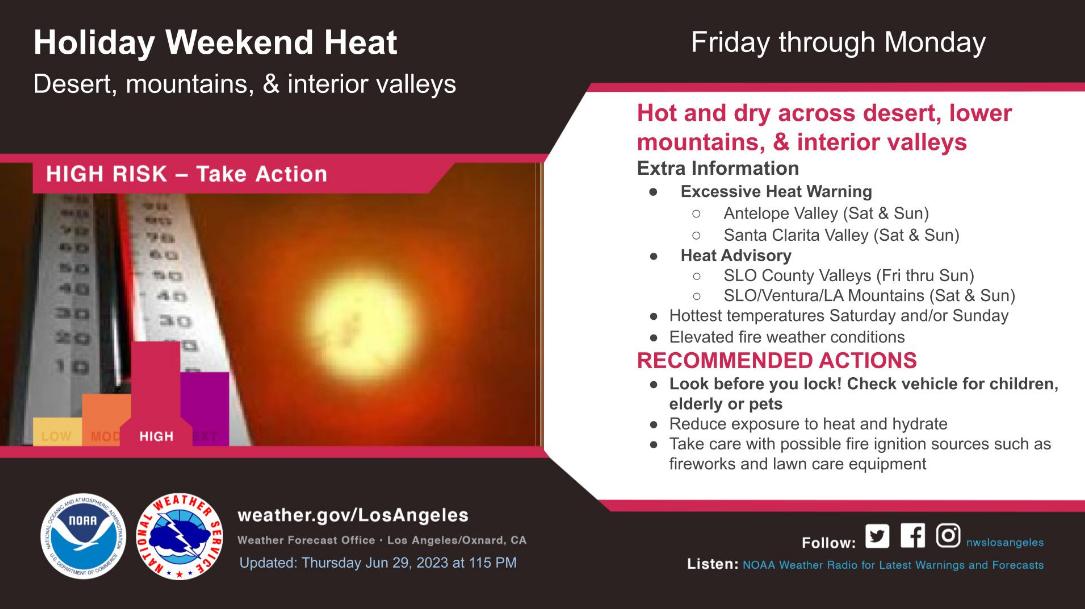
LOS ANGELES – The National Weather Service issued a warning noting that extremely hot and dry conditions are expected Friday through Monday, focused across the desert, lower mountains, and interior valleys.
Daytime high temperatures are expected to peak in the 90s to 109 degrees, hottest on Saturday and Sunday. Hot and very dry conditions will bring elevated fire weather conditions for interior areas, potentially bringing rapid plume dominated fire growth with any new fire starts.
The Los Angeles County Department of Public Health reminds everyone to take precautions to avoid heat-related illness this holiday weekend. Daytime high temperatures are expected to peak in the 90s to 109 degrees with hottest temperatures on Saturday.
Extreme heat poses a substantial health risk, especially for young children, the elderly, people with chronic diseases, pregnant individuals, people with disabilities, and people who are socially isolated who may be especially sensitive to negative health impacts from extreme heat.
Never leave infants, children, pets, or those with impairments alone in a parked car for any amount of time. Cars get very hot inside, even if the windows are ‘cracked’ or open – it can take only a few minutes for the temperatures inside a car to rise to levels that can kill. Call 911 if you see a child or pet in a car alone.
If you are at substantial health risk, have a friend or relative call to check on you twice a day during a heat wave. If you know someone who has a substantial health risk to heat – including those who are sick or have chronic conditions, older adults, pregnant women, children, and those who live alone– check on them at least twice a day. Infants and young children, of course, need much more frequent monitoring.
Here are simple but important steps to stay safe:
Stay Cool:
- Those lacking air conditioning should go to a cooling center, library or public place such as a shopping mall to cool off for a few hours each day.
- Electric fans may provide comfort, but when the temperature is in the high 90s, they will not prevent heat-related illnesses.
- Taking a cool shower or bath or moving to an air-conditioned place is a much better way to cool off. Additionally cool compresses may provide relief.
- Use your stove and oven less to maintain a cooler temperature in your home.
- If spending time outdoors, avoid physical exertion or exercising outdoors during the hottest parts of the day to avoid overheating. Get medical attention if you experience a rapid, strong pulse, feel delirious, or have a body temperature above 102 degrees Fahrenheit.
- Reduce exposure to the sun from 10 a.m. to 4 p.m. when UV rays are strongest and keep physical activities to a minimum during that time.
- Use cool compresses or misting.
- When working outside, drink plenty of fluids even if you are not thirsty and take rest breaks in the shade.
- Wear lightweight, loose fitting, light-colored clothing to reflect heat and sunlight.
- Wear a wide-brimmed hat to cover the face and neck and wear loose-fitting clothing to keep cool and to protect your skin from the sun and mosquitoes.
- Wear sunglasses that provide 100 percent UVA and UVB protection. Chronic exposure to the sun can cause cataracts, which left untreated, can lead to blindness.
- Liberally apply sunscreen (at least SPF 15) 15 minutes before venturing outdoors and re-apply at least every two hours – sunscreen may reduce the risk of skin cancer, the number one cancer affecting Californians. Sunscreen may also prevent premature aging.
Stay Hydrated:
- Drink plenty of water or fluids and keep hydrated throughout the day. Drink more fluids, regardless of how active you are. Don’t wait until you’re thirsty to drink.
- Warning: If your doctor limits the amount you drink or has you on water pills, ask how much you should drink while the weather is hot.
- Stay away from very sugary, caffeinated, or alcoholic drinks—these cause you to lose more body fluid. Also avoid very cold drinks because they can cause stomach cramps.
- Replace salt and minerals: heavy sweating removes salt and minerals from the body that need to be replaced. A sports drink can replace the salt and minerals you lose in sweat.
- If you are on a low-salt diet, have diabetes, high blood pressure, or other chronic conditions, talk with your doctor before drinking a sports beverage or taking salt tablets.
- Keep your pets hydrated: provide plenty of fresh water for your pets and leave the water in a shady area.
Know the Signs of Heat-related illnesses and What to do:
Heat-related illness can be one or more of the following medical conditions including: heat rash, heat cramps, fainting, heat exhaustion, and heat stroke, which can lead to death. Warning signs of heat-related illness vary and may include heavy sweating, muscle cramps, weakness, headache, nausea or vomiting, paleness, tiredness, dizziness, or disorientation or confusion.
- Heat Cramps. Signs of heat cramps include muscle pains and spasms triggered by heavy activity. They usually involve the stomach muscles or the legs. If a person has heat cramps:
- Stop physical activity and move to a cool place.
- Drink water or a sports drink.
- Do not resume strenuous physical activities for several hours after heat cramps go away.
- Get medical help right away if: cramps last longer than 1 hour; someone is on a low-sodium diet; or someone has heart problems.
- Heat Exhaustion. Warning signs include heavy sweating, cramps, headache, nausea or vomiting, tiredness, weakness, dizziness, and fainting. If a person has heat exhaustion:
- Move to a cool place.
- Rest, lying down.
- Loosen clothes.
- Put cool, wet cloths on the body (head, neck, armpits, and groin) or take a cool shower or bath.
- Sip cool, nonalcoholic beverages water.
- Get medical help right away if someone is throwing up; symptoms get worse; or symptoms last longer than one hour.
- Heat Stroke. Heat stroke is a medical emergency. Warning signs of heat stroke include red, hot, dry skin; very high body temperature; dizziness; nausea; confusion, strange behavior, or unconsciousness; rapid pulse or throbbing headache. If a person has heat stroke:
- Call 9-1-1 right away.
- Move the person to a cooler or shady place.
- Help lower the person’s temperature with cool wet cloths on head, neck, armpits and groin or a cool bath.
- Do not give the person anything to drink.
Public Health offers the additional recommendations during high temperature days:
- Take care with possible fire ignition sources such as fireworks and lawn care equipment.
- Keep children safe in and around cars. NEVER leave an infant or child alone in a car. Touch a child’s safety seat and safety belt before using it to ensure it’s not too hot before securing a child.
- Teach children not to play in, on, or around cars. They could accidentally trap themselves in a hot vehicle.
- Always lock car doors and trunks – even at home – and keep keys out of children’s reach.
- Always make sure children have left the car when you reach your destination.
- Check on family, friends and neighbors who are at risk for heat-related illness, like those who are sick or have chronic conditions, older adults, pregnant women, children, those who live alone, pets, and outdoor workers and athletes. Call 911 right away if you see these symptoms: high body temperature (103°F or higher), vomiting, dizziness, confusion, and hot, red, dry, or damp skin. Heat stroke is a medical emergency.
- Eat light, cool, easy-to-digest foods such as fruit or salads. If you pack food, put it in a cooler or carry an ice pack. Don’t leave it sitting in the sun. Meats and dairy products can spoil quickly in hot weather.
- If you are wearing a mask, avoid strenuous workouts wearing face coverings or masks not intended for athletic purposes.
- Visit your power company’s website or contact them by phone to determine if you are scheduled for a rolling power outage.
Stay Informed:
Check for updates: Check your local news for weather forecasts, extreme heat alerts, and safety tips, and to learn about any cooling centers in your area.
County and City partners have planned ways to safely operate cooling centers during times of high heat. Residents who do not have access to air conditioning are encouraged to take advantage of these free cooling centers. To find a location near you, visit https://ready.lacounty.gov/heat/ or call 211.
Los Angeles County residents and business owners, including people with disabilities and others with access and functional needs can call 2-1-1 for emergency preparedness information and other referral services. The toll-free 2-1-1 number is available 24 hours a day, seven days a week. 211 LA County services can also be accessed by visiting 211la.org.
Community Services - PSA
LGBTQ+ voter education town hall held tonight in Los Angeles
Unique Women’s Coalition, Equality California and FLUX host discussion on upcoming election.
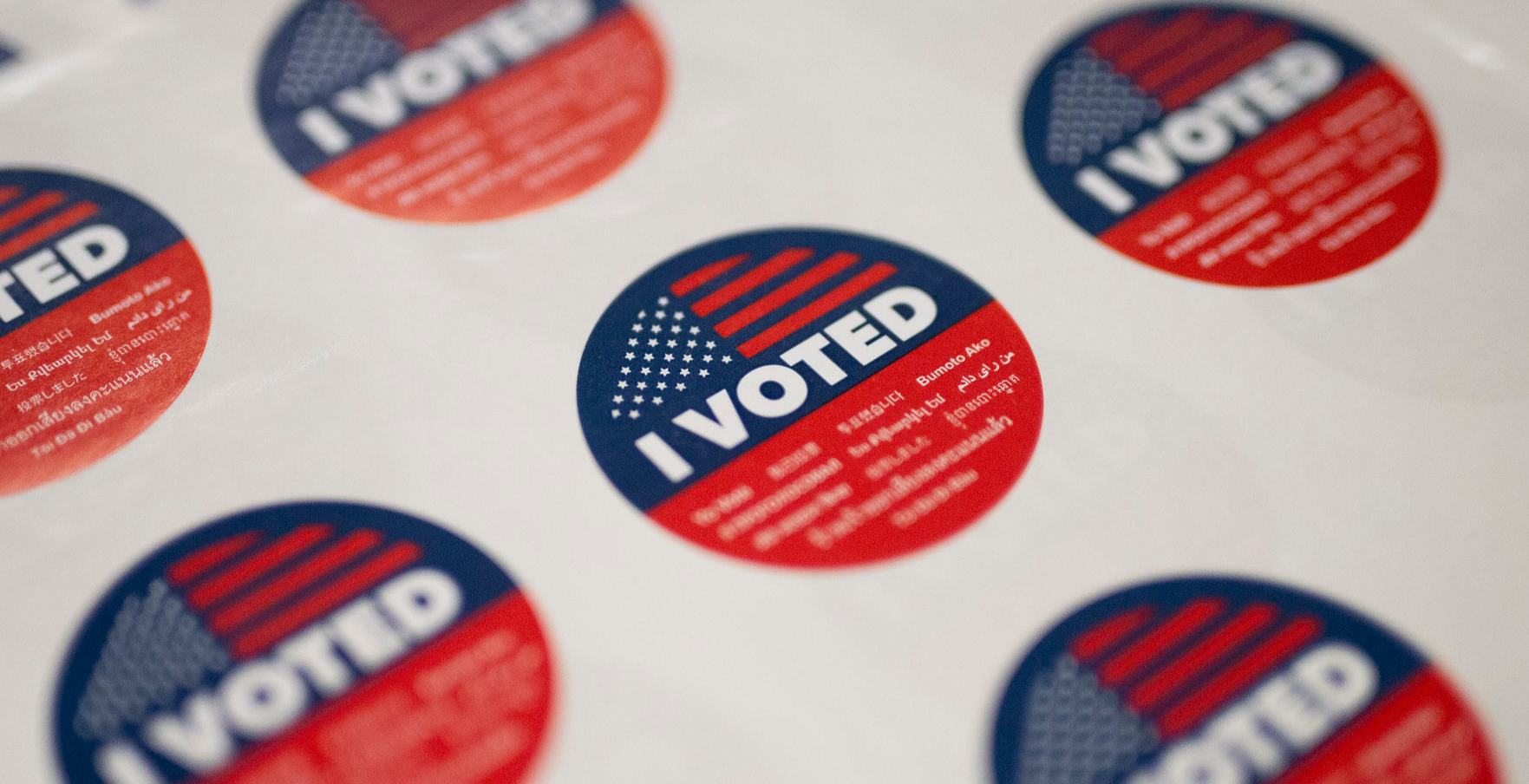
The Unique Women’s Coalition, Equality California and FLUX, a national division of the AIDS Healthcare Foundation, will host their second annual voter education town hall today at the Connie Norman Transgender Empowerment Center in Los Angeles from 7PM to 9PM tonight.
The organizations will present and discuss ballot propositions and measures that will appear on the November ballot and that affect the LGBTQ+ community in this part of the town hall series titled ‘The Issues.’
“The trans and nonbinary community is taking its seat at the table, and we are taking the time and space to be informed and prepare the voter base,” said Queen Victoria Ortega, international president of FLUX.
The town hall will feature conversations through a Q&A followed by a reception for program participants, organizational partners and LGBTQ+ city and county officials.
There will later be a third town hall before the election and The Connie Norman Transgender Empowerment Center will also become a voting location for anyone who feels like they need a safe space to vote, regardless of what voting district they are a part of.
“Our community is really asking for a place to talk about what all of this actually means because although we live in a blue sphere, housing and other forms of discrimination are still a very real threat,” said Scottie Jeanette Madden, director of advocacy at The Connie Norman Transgender Empowerment Center.
Southern California
Triple A: SoCal gas prices continue dropping quickly
The average price for self-serve regular gasoline in California is $4.87, which is 11 cents lower than a week ago
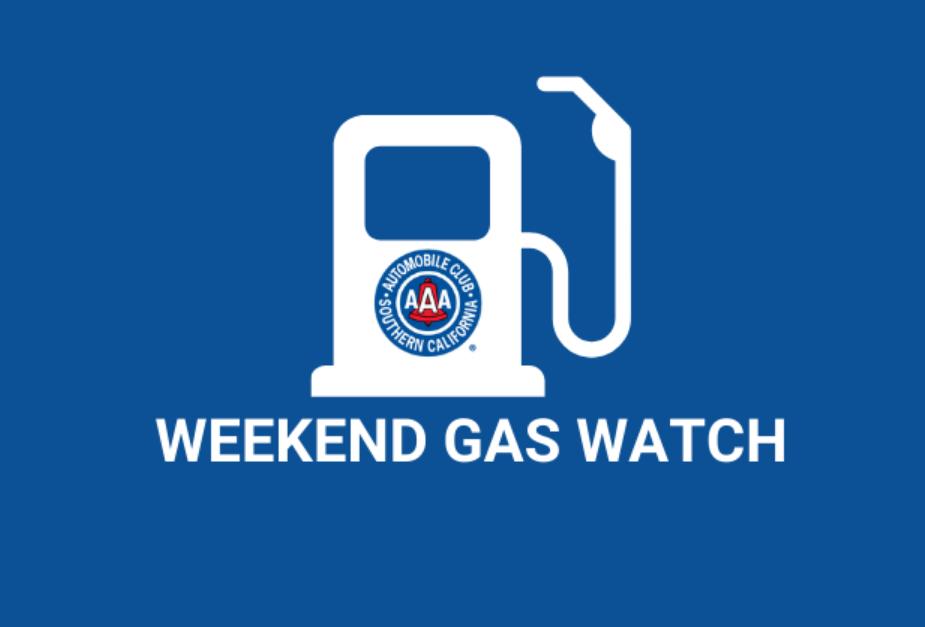
LOS ANGELES – Gas prices in Southern California have dropped by more than 50 cents a gallon in most areas after two straight months of price declines, according to the Auto Club’s Weekend Gas Watch. The average price for self-serve regular gasoline in California is $4.87, which is 11 cents lower than a week ago. The average national price is $3.46, which is two cents lower than a week ago.
The average price of self-serve regular gasoline in the Los Angeles-Long Beach area is $4.83 per gallon, which is 10 cents less than last week and 13 cents less than last year. In San Diego, the average price is $4.85, which is 10 cents lower than last week and eight cents lower than this time last year.
On the Central Coast, the average price is $4.97, which is five cents lower than last week and two cents higher than last year. In Riverside, the average per-gallon price is $4.75, which is 10 cents lower than last week and 10 cents lower than a year ago. In Bakersfield, the $4.96 average price is eight cents less than last week and nine cents higher than a year ago today.
“Oil Price Information Service reports the latest Energy Information Administration data shows that West Coast refinery utilization rates reached their highest production levels of 2024 at the beginning of this month,” said Auto Club Spokesperson Doug Shupe. “California continues to have the highest gas prices in the U.S., but this week for the first time since March, gas prices in most local areas are lower than at this time a year ago.”
The Weekend Gas Watch monitors the average price of gasoline. As of 9 a.m. on June 13, averages are:

Southern California
Triple A: Statewide gas price average drops below $5 a gallon
The average price for self-serve regular gasoline in California is $4.98, which is 11 cents lower than a week ago

LOS ANGELES – The California gas price average dropped below $5 a gallon for the first time since late March, according to the Auto Club’s Weekend Gas Watch. The average price for self-serve regular gasoline in California is $4.98, which is 11 cents lower than a week ago. The average national price is $3.48, which is eight cents lower than a week ago.
The average price of self-serve regular gasoline in the Los Angeles-Long Beach area is $4.93 per gallon, which is 12 cents less than last week and the same price as last year. In San Diego, the average price is $4.95, which is 12 cents lower than last week and six cents higher than this time last year.
On the Central Coast, the average price is $5.02, which is eight cents lower than last week and 12 cents higher than last year. In Riverside, the average per-gallon price is $4.95, which is 11 cents lower than last week and three cents higher than a year ago. In Bakersfield, the $5.04 average price is eight cents less than last week and 17 cents higher than a year ago today.
“According to Oil Price Information Service, Los Angeles wholesale gasoline prices are dropping as large supplies of imported gasoline continue to arrive in Southern California,” said Auto Club Spokesperson Doug Shupe. “A few Southern California gas stations are now charging less than $4.10 a gallon for regular unleaded.”
The Weekend Gas Watch monitors the average price of gasoline. As of 9 a.m. on June 6, averages are:

Southern California
‘Heat dome’ brings scorching conditions but coastal areas spared
The Los Angeles County Health Officer has issued an excessive heat warning as high temperatures have been forecast
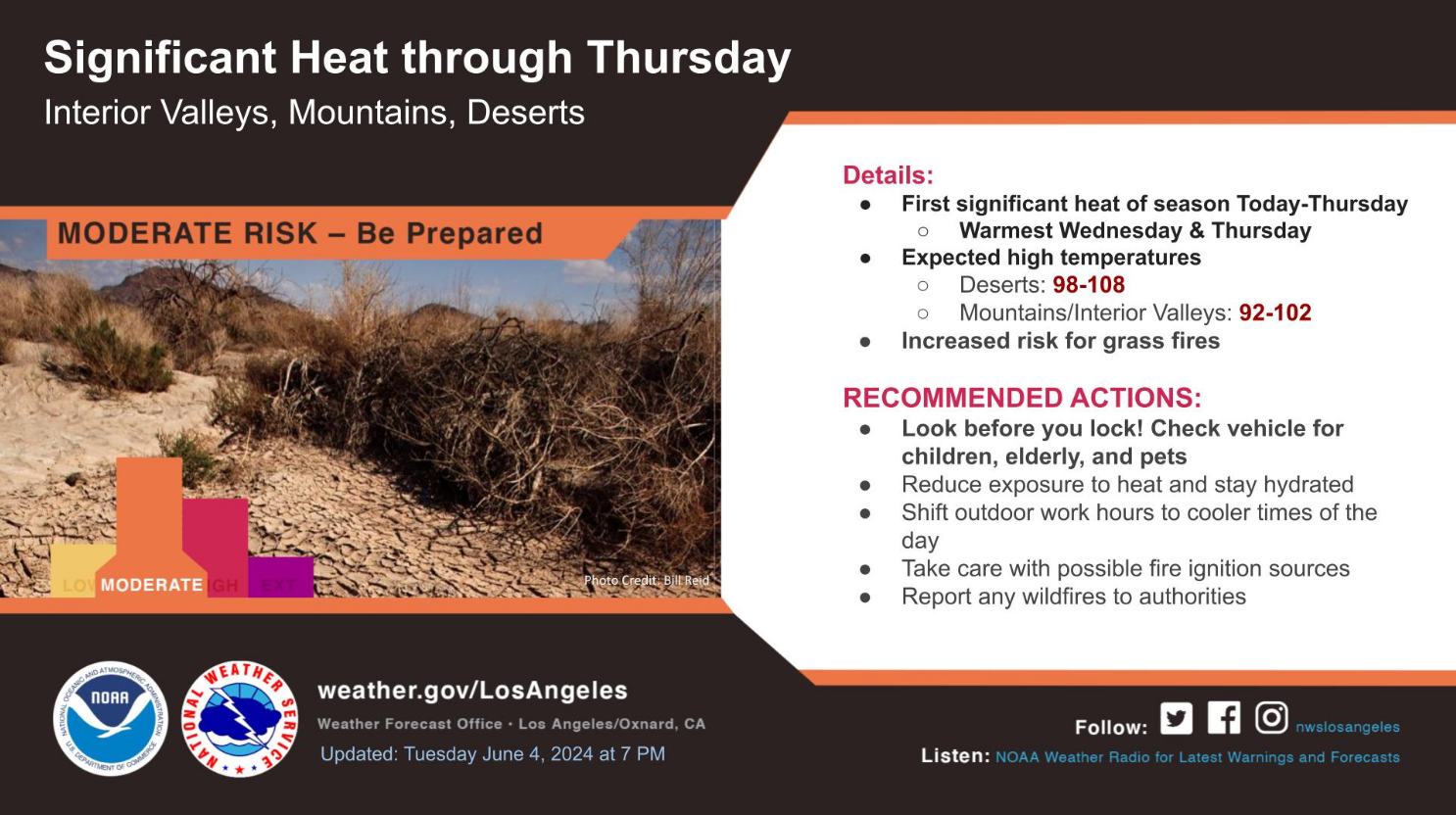
OXNARD, Calif. – The first significant heat of the season has arrived for the interior, and is expected to last into Thursday. Temperatures will be warmest Wednesday and Thursday, with highs in the deserts from 98 to 108, and 92 to 102 for the mountains and interior valleys.
Drier conditions along with breezy conditions will lead to an increased risk for grass fires. Reduce exposure to the heat, and stay hydrated. Look before locking vehicles for children, elderly and pets. Vehicles can become dangerously hot in a short period of time. Report any wildfires to authorities.
High Temperatures Forecast for Parts of Los Angeles County
The Los Angeles County Health Officer has issued an excessive heat warning as high temperatures have been forecast for the following areas:
- Antelope Valley: Wednesday June 05, 2024 through Thursday June 06, 2024
- Western Antelope Valley: Wednesday June 05, 2024 through Thursday June 06, 2024
- Eastern Antelope Valley: Wednesday June 05, 2024 through Thursday June 06, 2024
Public Health reminds everyone to take precautions to avoid heat-related illness, especially older adults, young children, outdoor workers, athletes, and people with a chronic medical condition who are especially sensitive to negative health impacts from extreme heat. Public Health offers the following recommendations during high temperature days:
- Drink plenty of water and keep hydrated throughout the day.
- If you must go out, plan your day to avoid going out during the hottest hours, and wear sunscreen. Wear lightweight, light-colored clothes, and wear a hat or use an umbrella.
- Cars get very hot inside, even if the windows are ‘cracked’ or open. Never leave children or pets in cars. Call 911 if you see a child or pet in a car alone.
- Beware of and know what to do for heat-related illness, such as heat exhaustion and heat stroke. Call 911 right away if you see these symptoms: high body temperature (103°F or higher), vomiting, dizziness, confusion, and hot, red, dry, or damp skin. Heat stroke is a medical emergency.
- Check on those at risk for heat-related illness, like those who are sick or have chronic conditions, older adults, pregnant women, children, those who live alone, pets, and outdoor workers and athletes.
- If you are wearing a mask, avoid strenuous workouts wearing face coverings or masks not intended for athletic purpose
- Visit your power company’s website or contact them by phone to determine if you are scheduled for a rolling power outage.
“On hot days, it’s important for everyone to both take care of themselves and check on others, especially those who have a higher chance of getting ill due to the heat. Some of them include children, the elderly, those with health conditions, pregnant people, those living alone, and pets,” said Muntu Davis, MD, MPH, Los Angeles County Health Officer. “Hot days can be dangerous for anyone, so it’s crucial to stay cool and hydrated. Never leave children, the elderly, or pets alone in hot homes, places, or vehicles. Make sure to check on elderly or unwell neighbors and relatives regularly.”
County and City partners have planned ways to safely operate cooling centers during times of high heat. Residents who do not have access to air conditioning are encouraged to take advantage of these free cooling centers. To find a location near you, visit https://ready.lacounty.gov/heat/ or call 211.
Los Angeles County residents and business owners, including people with disabilities and others with access and functional needs can call 2-1-1 for emergency preparedness information and other referral services. The toll-free 2-1-1 number is available 24 hours a day, seven days a week. 211 LA County services can also be accessed by visiting 211la.org.
Southern California
Triple A: Finally, some SoCal cities drop below $5 a gallon
The average price for self-serve regular gasoline in California is $5.09, which is six cents lower than a week ago

LOS ANGELES – Six straight weeks of price drops at Southern California gas stations have pushed average prices below $5 a gallon in a few cities, according to the Auto Club’s Weekend Gas Watch. The average price for self-serve regular gasoline in California is $5.09, which is six cents lower than a week ago. The average national price is $3.56, which is four cents lower than a week ago.
The average price of self-serve regular gasoline in the Los Angeles-Long Beach area is $5.05 per gallon, which is six cents less than last week and 12 cents higher than last year. In San Diego, the average price is $5.07, which is six cents lower than last week and 17 cents higher than this time last year.
On the Central Coast, the average price is $5.10, which is six cents lower than last week and 21 cents higher than last year. In Riverside, the average per-gallon price is $4.96, which is six cents lower than last week and 13 cents higher than a year ago. In Bakersfield, the $5.12 average price is five cents less than last week and 29 cents higher than a year ago today.
“Oil Price Information Service reports that wholesale Los Angeles gasoline prices are continuing to drop because of increased availability of imported gasoline and reportedly lower levels of demand compared to last year,” said Auto Club Spokesperson Doug Shupe. “Those factors should help pump price drops to continue for now.”
The Weekend Gas Watch monitors the average price of gasoline. As of 9 a.m. on May 30, averages are:

Southern California
Triple A: Memorial Day travelers get a break at the pump
The average price for self-serve regular gasoline in California is $5.15, which is nine cents lower than a week ago

LOS ANGELES – Gas prices continued downward for a fifth straight week, giving some Southern California Memorial Day travelers the chance to fill up for about $4.50 a gallon or even less in a few areas, according to the Auto Club’s Weekend Gas Watch. The average price for self-serve regular gasoline in California is $5.15, which is nine cents lower than a week ago. The average national price is $3.61, which is one cent higher than a week ago.
The average price of self-serve regular gasoline in the Los Angeles-Long Beach area is $5.11 per gallon, which is ten cents less than last week, 27 cents less than last month, and 25 cents higher than last year. In San Diego, the average price is $5.13, which is ten cents lower than last week, 23 cents lower than last month, and 29 cents higher than this time last year.
On the Central Coast, the average price is $5.16, which is five cents lower than last week, 17 cents lower than last month, and 30 cents higher than last year. In Riverside, the average per-gallon price is $5.02, which is ten cents lower than last week, 28 cents lower than last month and 25 cents higher than a year ago. In Bakersfield, the $5.17 average price is five cents less than last week, 15 cents less than last month, and 36 cents higher than a year ago today.
“With an all-time record number of Southern California travelers expected for this Memorial Day getaway weekend, the gas price drops are providing some welcome relief,” said Auto Club Spokesperson Doug Shupe. “Those travelers who are planning out-of-state trips should expect to pay even less when they fuel up for their return, since California continues to be the only U.S. state with a gas price average above $5 a gallon.”
The Weekend Gas Watch monitors the average price of gasoline. As of 9 a.m. on May 23, averages are:

Southern California
Triple A: Gas prices drop for four straight weeks
The average price for self-serve regular gasoline in California is $5.24, which is eight cents lower than a week ago

LOS ANGELES – Local gas prices have dropped for four straight weeks, but California continues to be the only state with an average price above $5 a gallon, according to the Auto Club’s Weekend Gas Watch. The average price for self-serve regular gasoline in California is $5.24, which is eight cents lower than a week ago. The average national price is $3.60, which is four cents lower than a week ago.
The average price of self-serve regular gasoline in the Los Angeles-Long Beach area is $5.21 per gallon, which is eight cents less than last week, 18 cents less than last month, and 37 cents higher than last year. In San Diego, the average price is $5.23, which is six cents lower than last week, 14 cents lower than last month, and 41 cents higher than this time last year.
On the Central Coast, the average price is $5.22, which is five cents lower than last week, 14 cents lower than last month, and 38 cents higher than last year. In Riverside, the average per-gallon price is $5.12, which is eight cents lower than last week, 19 cents lower than last month and 36 cents higher than a year ago. In Bakersfield, the $5.23 average price is three cents less than last week, eight cents less than last month, and 40 cents higher than a year ago today.
“California continues to have the highest average gas prices in the U.S., and despite a month of price declines, the state average price is still more than 40 cents higher than Hawaii, which is the second most expensive state for fuel,” said Auto Club Spokesperson Doug Shupe.
The Weekend Gas Watch monitors the average price of gasoline. As of 9 a.m. on May 16, averages are:

Southern California
Triple A: Gas prices head down for third straight week
The average price for self-serve regular gasoline in California is $5.32, which is six cents lower than a week ago

LOS ANGELES – Southern California gas prices have dropped for the third straight week, according to the Auto Club’s Weekend Gas Watch. The average price for self-serve regular gasoline in California is $5.32, which is six cents lower than a week ago. The average national price is $3.64, which is three cents lower than a week ago.
The average price of self-serve regular gasoline in the Los Angeles-Long Beach area is $5.28 per gallon, which is six cents less than last week, six cents less than last month, and 42 cents higher than last year. In San Diego, the average price is $5.29, which is five cents lower than last week, five cents lower than last month, and 44 cents higher than this time last year.
On the Central Coast, the average price is $5.27, which is six cents lower than last week, two cents lower than last month, and 41 cents higher than last year. In Riverside, the average per-gallon price is $5.20, which is seven cents lower than last week, five cents lower than last month and 43 cents higher than a year ago. In Bakersfield, the $5.26 average price is four cents less than last week, five cents more than last month, and 42 cents higher than a year ago today.
“According to Oil Price Information Service (OPIS), California and all West Coast refineries are continuing to operate at higher capacities and West Coast gasoline inventories are increasing in anticipation of higher summer demand,” said Auto Club Spokesperson Doug Shupe.
The Weekend Gas Watch monitors the average price of gasoline. As of 9 a.m. on May 9, averages are:

Southern California
Triple A: SoCal gas prices continue downward
The average price for self-serve regular gasoline in California is $5.38, which is three cents lower than a week ago

LOS ANGELES – Southern California gas prices are continuing to drop for a second straight week, according to the Auto Club’s Weekend Gas Watch. The average price for self-serve regular gasoline in California is $5.38, which is three cents lower than a week ago. The average national price is $3.67, which is one cent higher than a week ago.
The average price of self-serve regular gasoline in the Los Angeles-Long Beach area is $5.34 per gallon, which is three cents less than last week, 18 cents higher than last month, and 44 cents higher than last year. In San Diego, the average price is $5.34, which is two cents lower than last week, 19 cents higher than last month, and 45 cents higher than this time last year.
On the Central Coast, the average price is $5.33, which is the same as last week, 22 cents higher than last month, and 45 cents higher than last year. In Riverside, the average per-gallon price is $5.27, which is two cents lower than last week, 21 cents higher than last month and 45 cents higher than a year ago. In Bakersfield, the $5.30 average price is one cent less than last week, 29 cents more than last month, and 44 cents higher than a year ago today.
“After a few months of supply interruptions from refinery breakdowns and maintenance, Oil Price Information Service (OPIS) reports that California refineries have been operating at above 86% of their capacity for the past two weeks,” said Auto Club Spokesperson Doug Shupe. “Additionally, OPIS reported the US Energy Information Administration believes that the country has already experienced its highest gas price point for the first half of this year. Although California prices often go against national trends, that prediction is an encouraging sign for further price drops at the pump.”
The Weekend Gas Watch monitors the average price of gasoline. As of 9 a.m. on May 2, averages are:

Southern California
Triple A: Southern California gas prices begin to slowly decrease
The average price for self-serve regular gasoline in California is $5.41, which is four cents lower than a week ago

LOS ANGELES – Southern California gas prices slightly decrease in almost every metro city, according to the Auto Club’s Weekend Gas Watch. The average price for self-serve regular gasoline in California is $5.41, which is four cents lower than a week ago. The average national price is $3.66, which is also one cent higher than a week ago.
The average price of self-serve regular gasoline in the Los Angeles-Long Beach area is $5.37 per gallon, which is two cents less than last week, 33 cents higher than last month, and 44 cents higher than last year. In San Diego, the average price is $5.36, which is two cents lower than last week, 34 cents higher than last month, and 45 cents higher than this time last year.
On the Central Coast, the average price is $5.33, which is two cents lower than last week, 31 cents higher than last month, and 43 cents higher than last year. In Riverside, the average per-gallon price is $5.29, which is three cents lower than last week, 37 cents higher than last month, and 45 cents higher than a year ago. In Bakersfield, the $5.31 average price is the same as last week, 40 cents more than last month, and 43 cents higher than a year ago today.
“For the first time in almost two months prices in Southern California have slightly decreased,” said Auto Club Spokesperson Doug Shupe. “The reasons for gas prices moving lower include slowing domestic gasoline demand between Spring Break and summer travel, as well as the cost of crude oil retreating.”
The Weekend Gas Watch monitors the average price of gasoline. As of 9 a.m. on April 25, averages are:
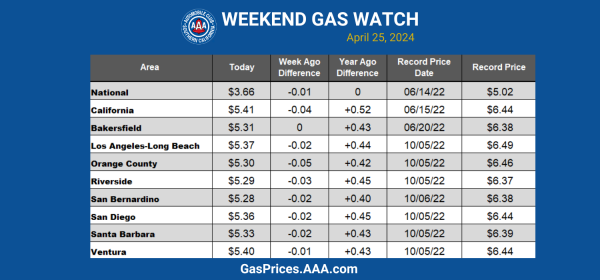
-
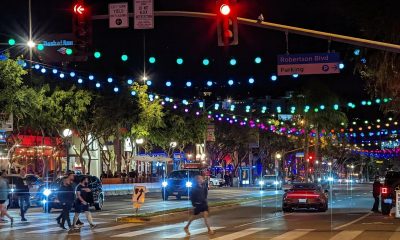
 Commentary4 days ago
Commentary4 days agoFinding myself in the West Hollywood nightlife scene
-

 Los Angeles4 days ago
Los Angeles4 days agoAIDS Healthcare Foundation will celebrate its legacy of food relief at the New Year’s Rose Parade
-

 Commentary3 days ago
Commentary3 days agoLooking back on ’25. Looking forward to ’26.
-

 Features2 days ago
Features2 days agoLegendary organizing activist Dolores Huerta, 95, rides in AHF’s ‘Food for Health’ Rose Parade float
-

 Movies3 days ago
Movies3 days agoThe 25 greatest queer movies of the 21st century so far
-

 Commentary2 days ago
Commentary2 days agoNew Year, New Queer: A polite reminder of the traditions that many of us make and many of us break that are well worth revisiting this particular year
-

 Parks & Recreation3 days ago
Parks & Recreation3 days agoFor more than two decades, Los Angeles Neighborhood Land Trust has worked to address park inequities
-

 Tarot Readings and Astrology1 day ago
Tarot Readings and Astrology1 day agoJanuary is calling for us to be grown-ups in Intuitive Shana’s New Year tarot reading
-

 Books5 hours ago
Books5 hours agoA look back at the best books of 2025


